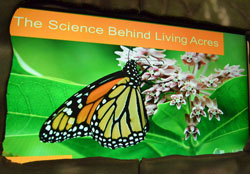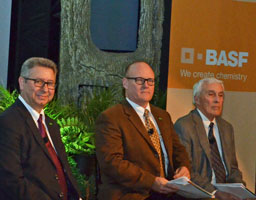The 10th annual BASF Science Behind media event prior to Commodity Classic this year was all about butterflies and research into establishing new habitat for these iconic insects and important pollinators.
 During the Science Behind Living Acres, BASF announced first-year findings from a biodiversity research initiative focused on helping increase the iconic monarch butterfly population through establishing milkweed in non-crop areas. The research, conducted last year on the BASF Research Farm in North Carolina, provides best practices for establishing and maintaining the plants in non-production areas.
During the Science Behind Living Acres, BASF announced first-year findings from a biodiversity research initiative focused on helping increase the iconic monarch butterfly population through establishing milkweed in non-crop areas. The research, conducted last year on the BASF Research Farm in North Carolina, provides best practices for establishing and maintaining the plants in non-production areas.
“Sustainability and biodiversity are two important areas of focus for BASF,” said Max Safarpour, Department Head, Director of Global Regulatory & Government Affairs, BASF. “Living Acres puts years of research and development experience to work to find a way for biodiversity to exist alongside modern agriculture.”
Listen to Safarpour explain more in this interview: Interview with Max Safarpour, BASF
BASF Field Biology Group Leader Luke Bozeman says they found that creating milkweed refuges will take an upfront investment of time, but once established it should support itself year after year with minimal effort.“The solution will not happen overnight,” said Bozeman. “But the effort taken to improve monarch butterfly habitats will quickly make an impact.”
Bozeman talks about how farmers can plant milkweed on non-crop acreage: Interview with Luke Bozeman, BASF
BASF research found milkweed plants are most successful when established through a planting process using root sections. Though it is common to plant milkweed by seeding, only a small number of common seeds germinate. Planting root stock or buds results in the most successful establishment.
“Plants from root sections are much more vigorous than seedlings and will grow rapidly,” said Dr. Harold Coble, professor emeritus of the faculty of North Carolina State University. “They can easily reach up to six feet in height under good growing conditions.”
Under a grant from BASF, Dr. Coble identified seven steps for successfully establishing milkweed in non-production areas: seed/root, pot, plant, spread, water, grow and mow. While some areas of a farm may better support milkweed stands than others, this work focuses on non-cropland areas such as ditches, roadsides, alleyways and other border areas.
Dr. Coble explains more in this interview: Interview with Dr. Harold Coble, NC State



